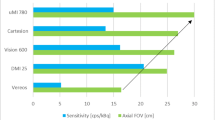Abstract
Advances in PET and SPECT and imaging hardware and software are vastly improving the noninvasive evaluation of myocardial perfusion and function. PET perfusion imaging has benefitted from the introduction of novel detectors that now allow true 3D imaging, and precise attenuation correction (AC). These developments have also resulted in perfusion images with higher spatial and contrast resolution that may be acquired in shorter protocols and/or with less patient radiation exposure than traditional PET or SPECT studies. Hybrid PET/CT cameras utilize transmission computed tomographic (CT) scans for AC, and offer the additional clinical advantages of evaluating coronary calcium and myocardial anatomy but at a higher cost than PET scanners that use 68Ge radioactive line sources. As cardiac PET systems continue to improve, dedicated cardiac SPECT systems are also undergoing a profound change in their design. The scintillation camera general purpose design is being replaced with systems with multiple detectors focused on the heart yielding 5 to 10 times the sensitivity of conventional SPECT. As a result, shorter acquisition times and/or lower tracer doses produce higher quality SPECT images than were possible before. This article reviews these concepts and compares the attributes of PET and SPECT instrumentation.







Similar content being viewed by others
References
Cherry SR, Sorenson JA, Phelps ME. Physics in nuclear medicine. 3rd ed. Philadelphia: Saunders; 2003. p. 511.
Garcia EV, Galt R, Faber TL, Chen J. Atlas of nuclear cardiology (3rd edn), In: Vasken D, Jagat N, editors. Current medicine LLC, Chapter 1. 2009. pp 1-34.
Garcia EV, Faber TL. Advances in nuclear cardiology instrumentation. Clinical potential of SPECT and PET. Curr Cardiovasc Imaging Rep 2009;2:230-7.
Lecomte R. Novel detector technology for clinical PET. Eur J Nucl Med Mol Imaging 2009;36:S69-85.
Hammer BE, Christensen NL, Heil BG. Use of magnetic field to increase spatial resolution of positron emission tomography. Med Phys 1994;21:1917-20.
Schaart DR, van Dam HT, Seifert S, Vinke R, Dendoover P, Lohner H, Beekman FJ. SiPM-array based PET detectors with depth-of-interaction correction. IEEE Nucl Sci Symposium Conference Record 2008; 3581-3585.
deKemp RA, Yoshinaga K, Beanlands RSB. Will 3-dimensional PET-CT enable the routine quantification of myocardial blood flow? J Nucl Cardiol 2007;14:380-97.
Votaw JR, White M. Comparison of 2-dimensional and 3-dimensional cardiac Rb-82 PET studies. J Nucl Med 2001;42:701-6.
Karp JS, Surti S, Daube-Witherspoon ME, Muehllehner G. Benefit of Time-of-Flight in PET: Experimental and clinical results. J Nucl Med 2008;49:462-70.
Livieratos L, Rajappan K, Stegger L, Schafers K, Bailey DL, Camici PG. Respiratory gating of cardiac PET data in list-mode acquisition. Eur J Nucl Med Mol Imaging 2006;33:584-8.
Meunier LL, Slomka PJ, Dey D, Ramesh A, Thomson LEJ, Hayes SW, et al. Motion frozen F-18-FDG cardiac PET. J Nucl Cardiol 2011;18:259-66.
Koepfli P, Hany TF, Wyss CA, Namdar M, Burger C, Konstantinidis AV, et al. CT attenuation correction for myocardial perfusion quantification using a PET/CT hybrid scanner. J Nucl Med 2004;45:537-42.
Nensa F, Poeppel TD, Beiderwellen K, Schelhorn J, Mahabadi AA, Erbel R, et al. Hybrid PET/MR imaging of the heart: Feasibility and initial results. Radiology. 2013;268:366-73.
http://www3.gehealthcare.com/en/products/categories/pet-ct/pet-ct_scanners/. Accessed Aug 11, 2014.
http://usa.healthcare.siemens.com/molecular-imaging/pet-ct. Accessed Aug 11, 2014.
http://www.healthcare.philips.com/main/products/nuclearmedicine/products/pet/. Accessed Aug 11, 2014.
http://www.positron.com/attrius. Accessed Aug 11, 2014.
How much does a PET/CT scanner cost? 2012/2013 update. http://info.blockimaging.com/bid/90851/How-Much-Does-a-PET-CT-Scanner-Cost-2012-2013-Update. Accessed Aug 11, 2014.
Anger HO. Scintillation camera. Rev Sci Instrum 1958;29:27-33.
Garcia EV, Faber TL. New trends in camera and software technology in nuclear cardiology. Cardiol Clin 2009;27:227-36.
Garcia EV. Are absolute myocardial blood flow PET measurements ready for clinical use? J Nucl Cardiol 2014;21:857-8.
Garcia EV. Are SPECT measurements of myocardial blood flow and flow reserve ready for clinical use? Eur J Nucl Med Mol Imaging 2014;41:2291-3.
Disclosure
The authors have indicated that they have no financial conflict of interest.
Author information
Authors and Affiliations
Corresponding author
Rights and permissions
About this article
Cite this article
Garcia, E.V. Proceedings of the cardiac PET summit meeting 12 may 2014: Cardiac PET and SPECT instrumentation. J. Nucl. Cardiol. 22, 563–570 (2015). https://doi.org/10.1007/s12350-015-0114-7
Received:
Accepted:
Published:
Issue Date:
DOI: https://doi.org/10.1007/s12350-015-0114-7




